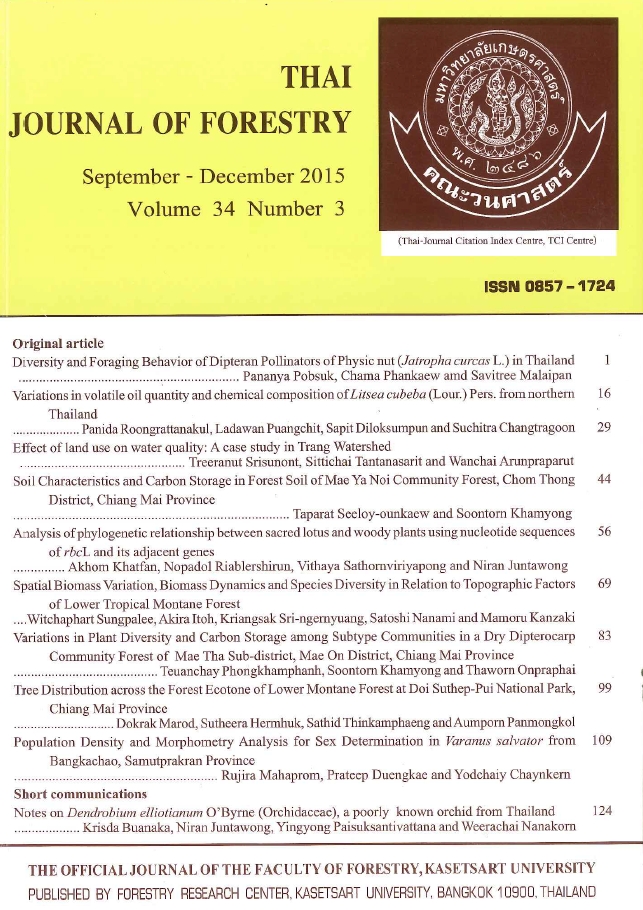Effect of land use on water quality: A case study in Trang Watershed
Main Article Content
บทคัดย่อ
This research study existing condition and investigate the factors affecting the DO and BOD level in Trang watershed. Result found that most dominant land use type was agriculture (73%). During year 2003 to 2010, the area of urban, industry, water body and other have been increased indicated urban expansion. While, agricultural land has been decreased and possibly converted to urban or other land. Surprisingly, the area of forest land has been increased (1.66%) in a significant manner indicating the good reforestation activities in the watershed. Water quality of Trang watershed in year 2011 was within water quality standard class 3. Result found that the correlation between DO and BOD with changing in land use types can be evaluated by simple linear regression analysis and pearson correlation coefficient (rxy). Factors affected on DO in Trang watershed are percentage of forest, agriculture, urban, industry, others land use, percentage development land use (PDLU), population density, temperature and electric conductivity respectively. Meanwhile, the BOD is affected by percentage of urban, industry, and EC respectively. The predicted model of DO and BOD could be accepted. It indicated that DO and BOD can be estimated by multiple linear regression analysis in Trang watershed. Therefore, higher percentages of developed land include industrial, urban, agricultural, cause water quality degradation. In the other hand, expansion of forest areas leads to improve water quality.
Keywords: DO and BOD, Land use, percentage of developed land use (PDLU)
Downloads
Article Details

อนุญาตภายใต้เงื่อนไข Creative Commons Attribution-NonCommercial-NoDerivatives 4.0 International License.
ข้าพเจ้าและผู้เขียนร่วม (ถ้ามี) ขอรับรองว่า ต้นฉบับที่เสนอมานี้ยังไม่เคยได้รับการตีพิมพ์และไม่ได้อยู่ในระหว่างกระบวนการพิจารณาตีพิมพ์ลงในวารสารหรือสิ่งตีพิมพ์อื่นใด ข้าพเจ้าและผู้เขียนร่วม (ถ้ามี) ยอมรับหลักเกณฑ์และเงื่อนไขการพิจารณาต้นฉบับ ทั้งยินยอมให้กองบรรณาธิการมีสิทธิ์พิจารณาและตรวจแก้ต้นฉบับได้ตามที่เห็นสมควร พร้อมนี้ขอมอบลิขสิทธิ์ผลงานที่ได้รับการตีพิมพ์ให้แก่วารสารวนศาสตร์ คณะวนศาสตร์ มหาวิทยาลัยเกษตรศาสตร์ กรณีมีการฟ้องร้องเรื่องการละเมิดลิขสิทธิ์เกี่ยวกับภาพ กราฟ ข้อความส่วนใดส่วนหนึ่ง หรือ ข้อคิดเห็นที่ปรากฏในผลงาน ให้เป็นความรับผิดชอบของข้าพเจ้าและผู้เขียนร่วม (ถ้ามี) แต่เพียงฝ่ายเดียว และหากข้าพเจ้าและผู้เขียนร่วม (ถ้ามี) ประสงค์ถอนบทความในระหว่างกระบวนการพิจารณาของทางวารสาร ข้าพเจ้าและผู้เขียนร่วม (ถ้ามี) ยินดีรับผิดชอบค่าใช้จ่ายทั้งหมดที่เกิดขึ้นในกระบวนการพิจารณาบทความนั้น”


